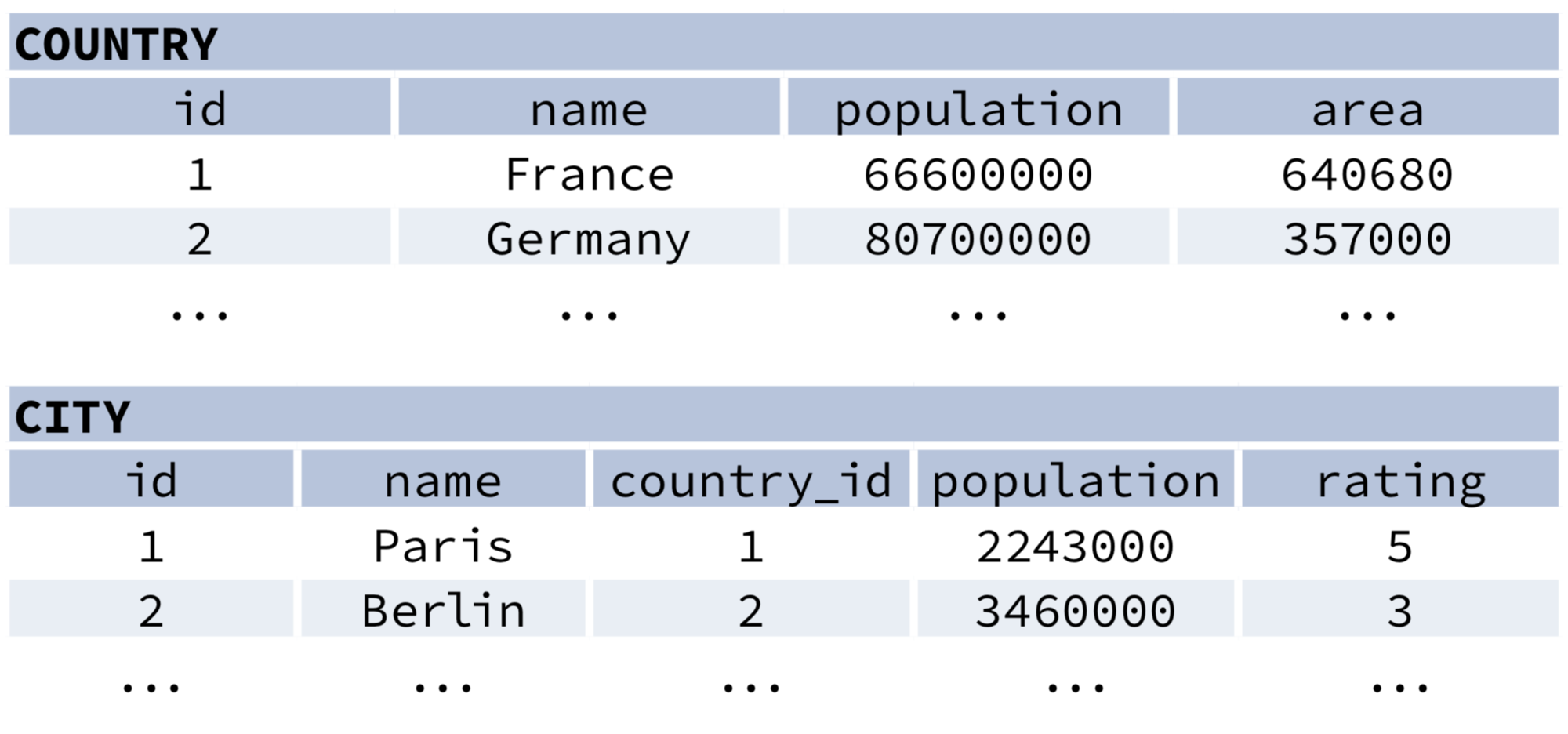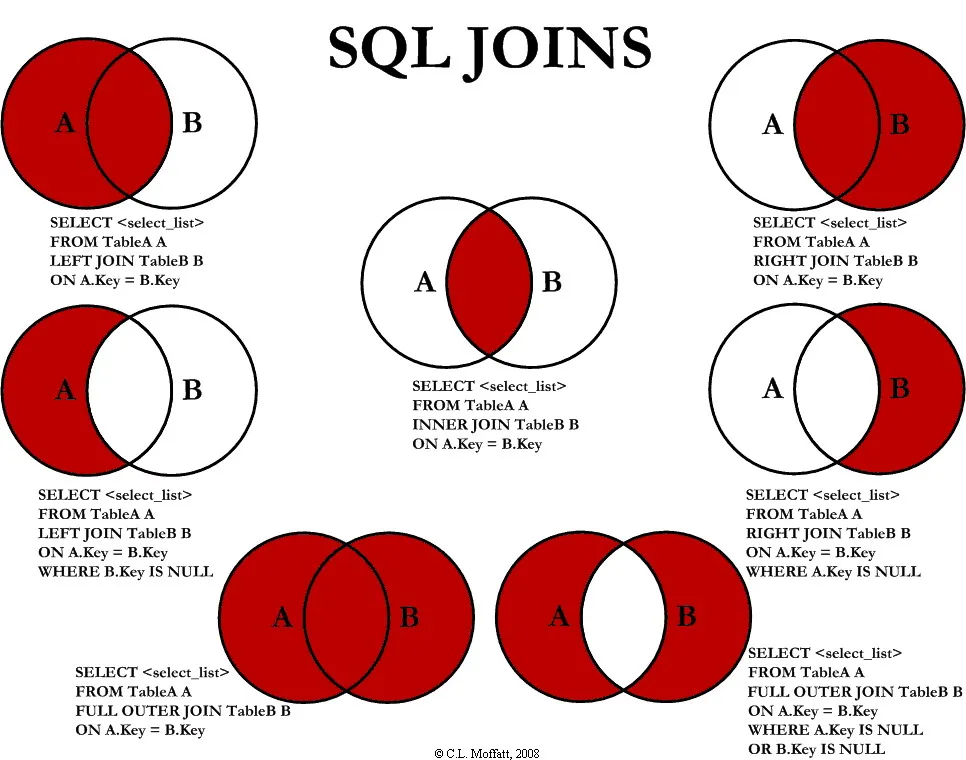SQL Refresher
SQL, or Structured Query Language, is a language to talk to databases. It allows you to select specific data and to build complex reports. Today, SQL is a universal language of data. It is used in practically all technologies that process data.
This cheatsheet is modified from https://learnsql.com/blog/sql-basics-cheat-sheet/
Sample Data
The following queries are based on this sample data

SELECT
- Fetch all columns from the
countrytable:
SELECT *
FROM country;
- Fetch
idandnamecolumns from thecitytable:
SELECT id, name
FROM city;
Order (ORDER BY)
- Fetch city
names sorted by theratingcolumn in the defaultASCending order:
SELECT name
FROM city
ORDER BY rating [ASC];
- Fetch city
names sorted by theratingcolumn in theDESCending order:
SELECT name
FROM city
ORDER BY rating DESC;
Query using aliases (AS)
- Aliasing Columns
SELECT name AS city_name
FROM city;
- Aliasing Table
SELECT co.name, ci.name
FROM city AS ci
JOIN country AS co
ON ci.country_id = co.id;
Filtering the output (WHERE)
Comparison Operators
- Fetch names of cities that have a rating above 3:
SELECT name
FROM city
WHERE rating > 3;
- Fetch names of cities that are neither Berlin nor Madrid:
SELECT name
FROM city
WHERE name != 'Berlin'
AND name != 'Madrid';
- Fetch names of cities that have a population between 500K and 5M:
SELECT name
FROM city
WHERE population BETWEEN 500000 AND 5000000;
OR
SELECT name
FROM city
WHERE population > 500000
AND population < 5000000;
Text Operators
- Fetch names of cities that start with a 'P' or end with an 's':
SELECT name
FROM city
WHERE name LIKE 'P%'
OR name LIKE '%s';
- Fetch names of cities that start with any letter followed by 'ublin' (like Dublin in Ireland or Lublin in Poland):
SELECT name
FROM city
WHERE name LIKE '%ublin';
Other Operators
- Fetch names of cities that don't miss a rating value:
SELECT name
FROM city
WHERE rating IS NOT NULL;
- Fetch names of cities that are in countries with IDs 1, 4, 7, or 8:
SELECT name
FROM city
WHERE country_id IN (1, 4, 7, 8);
SELECT with JOIN
This is to query from multiple tables at the same time.
This is a summary of all the join types.

INNER JOIN
JOIN (or explicitly INNER JOIN) returns rows that have matching values in both tables.
SELECT city.name, country.name
FROM city
[INNER] JOIN country
ON city.country_id = country.id;

LEFT JOIN
LEFT JOIN returns all rows from the left table with corresponding rows from the right table. If there's no matching row, NULLs are returned as values from the second table.
SELECT city.name, country.name
FROM city
LEFT JOIN country
ON city.country_id = country.id;

RIGHT JOIN
RIGHT JOIN returns all rows from the right table with corresponding rows from the left table. If there's no matching row, NULLs are returned as values from the left table.
SELECT city.name, country.name
FROM city
RIGHT JOIN country
ON city.country_id = country.id;

FULL JOIN
FULL JOIN (or explicitly FULL OUTER JOIN) returns all rows from both tables – if there's no matching row in the second table, NULLs are returned.
SELECT city.name, country.name
FROM city
FULL [OUTER] JOIN country
ON city.country_id = country.id;

CROSS JOIN
CROSS JOIN returns all possible combinations of rows from both tables. There are two syntaxes available.
SELECT city.name, country.name
FROM city
CROSS JOIN country;
SELECT city.name, country.name
FROM city, country;

GROUP BY - Aggregation And Grouping
GROUP BY groups together rows that have the same values in specified columns. It computes summaries (aggregates) for each unique combination of values.

Aggregate Functions
avg(expr) − average value for rows within the group
count(expr) − count of values for rows within the group
max(expr) − maximum value within the group
min(expr) − minimum value within the group
sum(expr) − sum of values within the group
Example Queries
Find out the number of cities:
SELECT COUNT(*)
FROM city;
Find out the number of cities with non-null ratings:
SELECT COUNT(rating)
FROM city;
Find out the number of distinctive country values:
SELECT COUNT(DISTINCT country_id)
FROM city;
Find out the smallest and the greatest country populations:
SELECT MIN(population), MAX(population)
FROM country;
Find out the total population of cities in respective countries:
SELECT country_id, SUM(population)
FROM city
GROUP BY country_id;
Find out the average rating for cities in respective countries if the average is above 3.0:
SELECT country_id, AVG(rating)
FROM city
GROUP BY country_id
HAVING AVG(rating) > 3.0;
Subqueries
A subquery is a query that is nested inside another query, or inside another subquery. There are different types of subqueries.
Single Value
The simplest subquery returns exactly one column and exactly one row. It can be used with comparison operators =, <, <=, >, or >=.
This query finds cities with the same rating as Paris:
SELECT name
FROM city
WHERE rating = (
SELECT rating
FROM city
WHERE name = 'Paris'
);
Multiple Values
A subquery can also return multiple columns or multiple rows. Such subqueries can be used with operators IN, EXISTS, ALL, or ANY.
This query finds cities in countries that have a population above 20M:
SELECT name
FROM city
WHERE country_id IN (
SELECT country_id
FROM country
WHERE population > 20000000
);
Correlated
A correlated subquery refers to the tables introduced in the outer query. A correlated subquery depends on the outer query. It cannot be run independently from the outer query.
This query finds cities with a population greater than the average population in the country:
SELECT *
FROM city main_city
WHERE population > (
SELECT AVG(population)
FROM city average_city
WHERE average_city.country_id = main_city.country_id
);
This query finds countries that have at least one city:
SELECT name
FROM country
WHERE EXISTS (
SELECT *
FROM city
WHERE country_id = country.id
);
Set Operations
Set operations are used to combine the results of two or more queries into a single result. The combined queries must return the same number of columns and compatible data types. The names of the corresponding columns can be different

UNION

UNION combines the results of two result sets and removes duplicates. UNION ALL doesn't remove duplicate rows.
This query displays German cyclists together with German skaters:
SELECT name
FROM cycling
WHERE country = 'DE'
UNION
SELECT name
FROM skating
WHERE country = 'DE';
With UNION ALL
SELECT name
FROM cycling
WHERE country = 'DE'
UNION ALL
SELECT name
FROM skating
WHERE country = 'DE';
INTERSECT

INTERSECT returns only rows that appear in both result sets.
This query displays German cyclists who are also German skaters at the same time:
SELECT name
FROM cycling
WHERE country = 'DE'
INTERSECT
SELECT name
FROM skating
WHERE country = 'DE';
EXCEPT

EXCEPT returns only the rows that appear in the first result set but do not appear in the second result set.
This query displays German cyclists unless they are also German skaters at the same time:
SELECT name
FROM cycling
WHERE country = 'DE'
EXCEPT / MINUS
SELECT name
FROM skating
WHERE country = 'DE';
INSERT
insert into cycling (name, country)
values
('YG', 'EG'),
(`MS`, 'EG');
UPDATE
UPDATE cycling SET name = 'Mo' WHERE id = 1;
DELETE
Delete all data in a table
DELETE from skating;
Delete with a condition
DELETE from skating WHERE id > 10;
Transactions
Run a transaction
begin transaction
update tass_police set bezahlt = 0 where id_fi_kunde = 3533 and id_fi_vers_art = 1700
commit
-- or rollback
Variables
Declare
DECLARE @veraenderung SMALLINT = 180;
DECLARE @neue_summe INT;
Function
A function can be called from inside a statement just like any other function and can return a scalar value.
Create - Get value from table
create function f_plic_bez()
returns decimal(10,2)
as begin
return (select sum(bezahlt) from tass_police)
end;
go
select dbo.f_plic_bez() AS 'Summe aller bezahlten Leistungen'
go
Drop
drop function f_bezahlt_versich
Create - With parameters
create function f_rabatt(@name varchar(40), @vers varchar(30))
returns int
as begin
return (select (praem_stufe-100)*10 from tass_police
join tbl_kunde on id_fi_kunde = id_kunde
join tkey_versicherung on id_fi_vers_art = id_vers_art
where name = @name and vers_bez = @vers)
end
Stored Procedure
Stored procedures are stored as precompilated code (stored routine) and called by the programmer wherever it wants to fire. Stored procedure can return value(s).
Create and execute
CREATE PROCEDURE p_polic_del @fname VARCHAR(30), @versich VARCHAR(30)
AS
BEGIN
DELETE FROM tass_police
FROM tbl_kunde, tkey_versicherung
WHERE name = @fname
AND id_kunde = id_fi_kunde
AND id_fi_vers_art = id_vers_art
AND vers_bez = @versich
IF @@ROWCOUNT = 0
PRINT 'Police existiert nicht.'
ELSE PRINT 'Löschung vollzogen.'
END
GO
EXECUTE p_polic_del 'Meier', 'Taggeld';